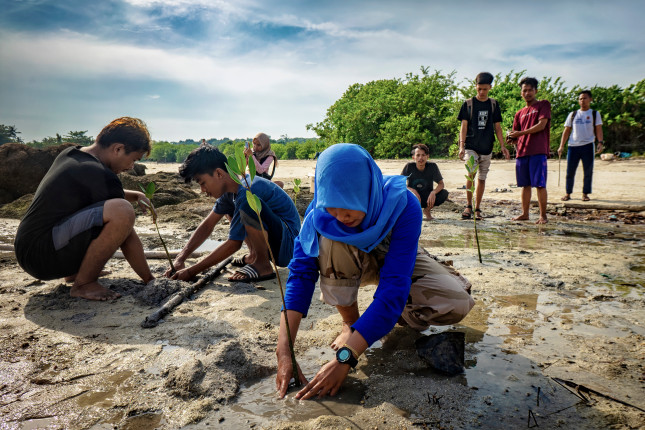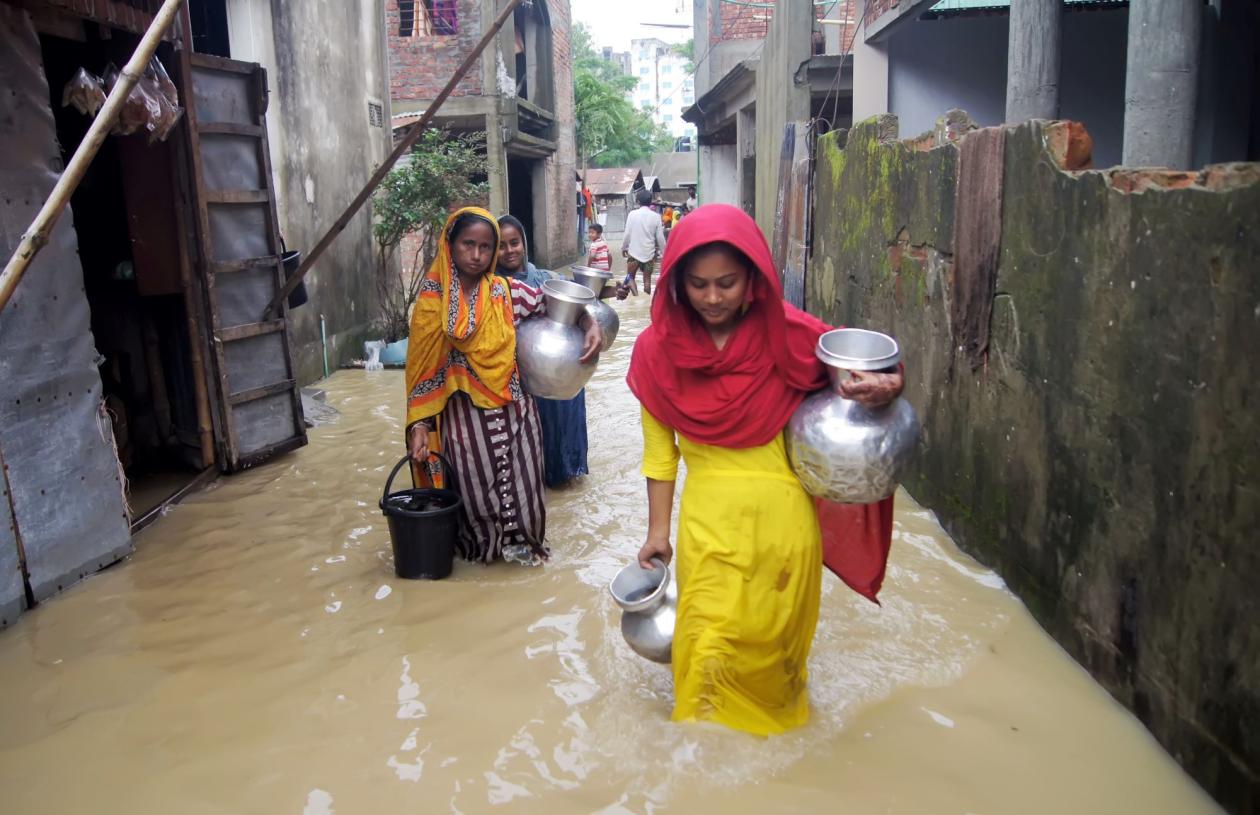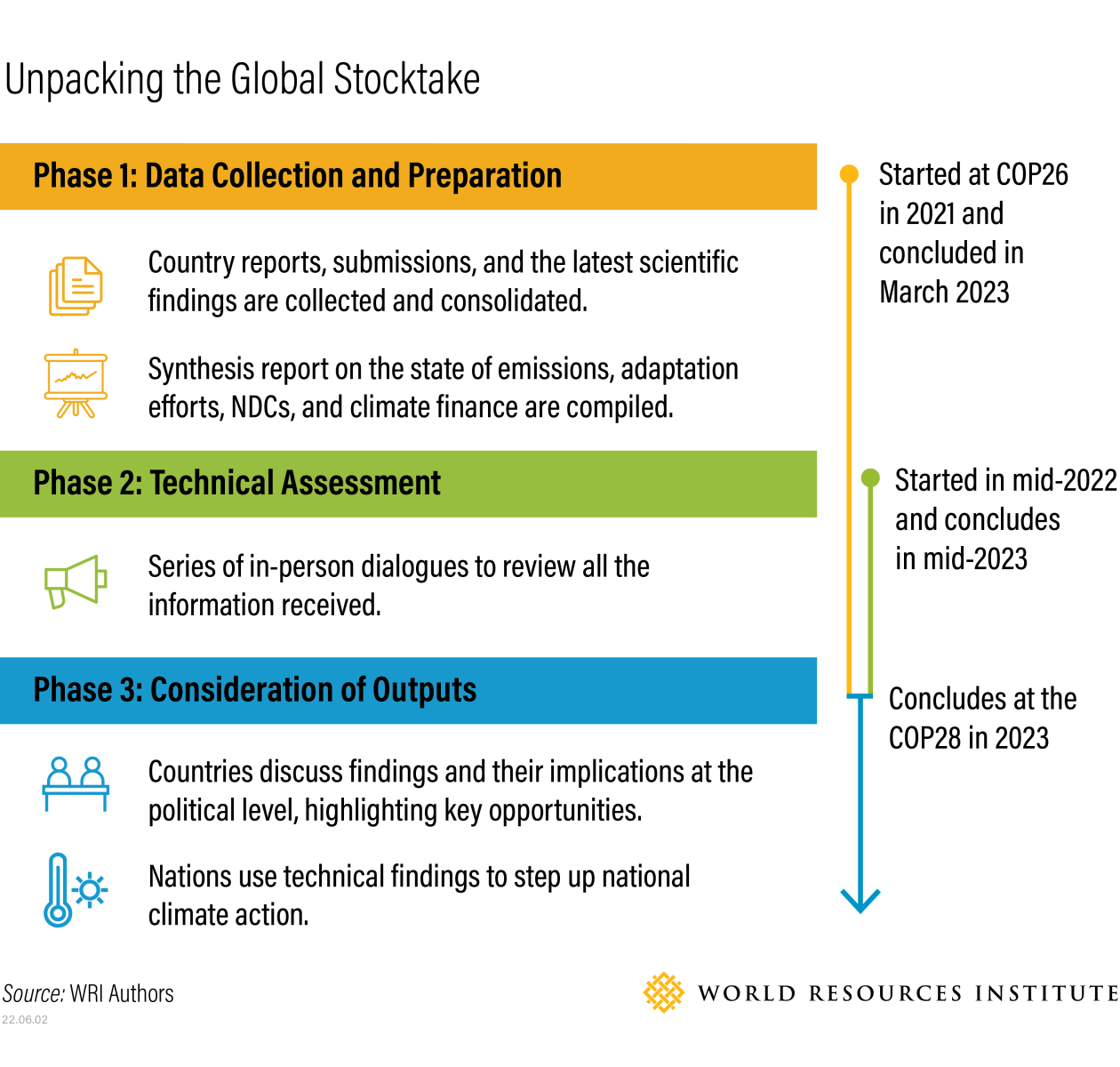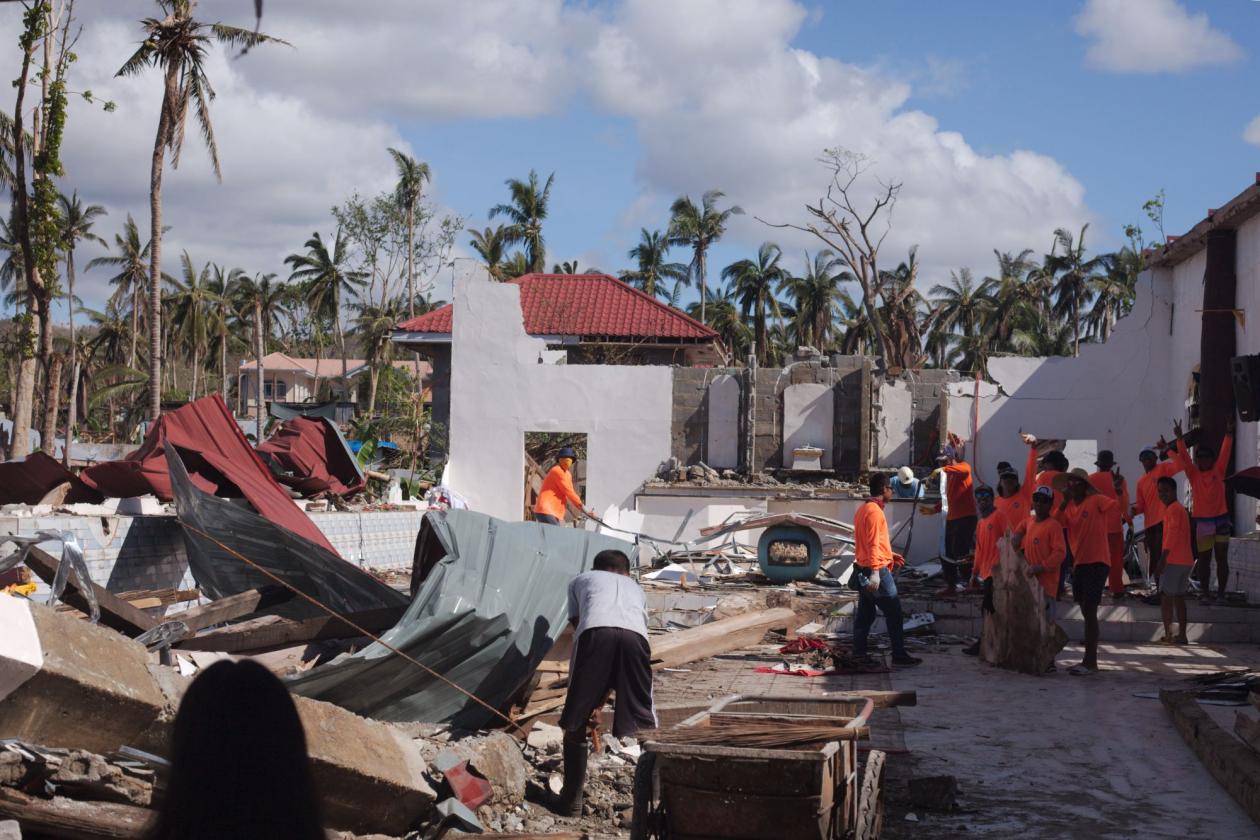
This year is a critical moment for climate action.
The mounting impacts of climate change, from floods and droughts to hurricanes and heat waves, are taking a major toll on human lives and economies globally — particularly in vulnerable developing nations with the fewest resources to protect themselves.
Current climate actions are not nearly enough to keep global warming below 1.5 degrees C (2.7 degrees F) and avoid the worst of these climate impacts, and countries must accelerate efforts to get on track. The latest Intergovernmental Panel on Climate Change (IPCC) report tells us that actions taken this decade will have impacts “for thousands of years.”
The Global Stocktake, happening in 2023 for the first time ever, offers a pivotal opportunity to correct course.
The Paris Agreement’s Global Stocktake process is designed to assess the global response to the climate crisis every five years. It evaluates the world’s progress on slashing greenhouse gas emissions, building resilience to climate impacts, and securing finance and support to address the climate crisis.
But this cannot be just another global assessment showing how far off track we are. The Stocktake process should also serve as a global accelerator, driving nations to step up their climate action and pursue the transformational change needed to secure a zero-carbon, climate-resilient and equitable future.
The Stocktake will conclude by the end of the UN climate summit in December 2023 (COP28). Countries must then agree on how they will leverage its findings to keep the global goal of limiting temperature rise to 1.5 degrees C alive and address the impacts of climate change.
Here’s what to know about the Global Stocktake and how it can foster global climate action:
What Is the Purpose of the Global Stocktake?
Established under Article 14 of the Paris Agreement, the Global Stocktake is designed “to assess the collective progress towards achieving the purpose of [the Paris] Agreement and its long-term goals.” Those goals include: cutting greenhouse gas emissions to limit global temperature rise to well below 2 degrees C (3.6 degrees F) and ideally 1.5 degrees C (2.7 degrees F); building resilience to climate impacts; and aligning financial support with the scale and scope needed to tackle the climate crisis.

The Global Stocktake is intended to evaluate progress on climate action at the global level — not the national level — and identify overall gaps to achieve the Paris Agreement as well as opportunities to bridge them.
But the Global Stocktake is meant to go far beyond an assessment.
In the Paris Agreement, Parties agreed that the Stocktake should inform countries in updating and enhancing their climate actions and support, and in enhancing international cooperation for climate action. It should also inform countries’ new climate plans (known as “nationally determined contributions,” or NDCs) which will be fully updated next in 2025. Conducting the Global Stocktake every five years is meant to ensure that countries and others are increasingly ambitious with their actions to keep the Paris Agreement’s goals in reach.
If undertaken effectively, the Global Stocktake can provide the basis that guides countries’ and non-state actors’ climate policy and investment decisions. And it can help drive transformational action across systems like energy, nature, food and transport.
Which Aspects of Climate Action Does the Global Stocktake Assess?
At COP24 in Katowice, Poland in 2018, countries agreed that the Global Stocktake would address climate progress in three key areas:
- Mitigation: Evaluating global efforts to reduce greenhouse gas emissions and keep global temperature rise below 2 degrees C (3.6 degrees F) and ideally 1.5 degrees C (2.7 degrees F), and identifying opportunities for additional emissions cuts.
- Adaptation: Measuring progress in countries’ abilities to enhance their resilience and reduce vulnerability to climate impacts.
- Means of implementation, including finance, technology transfer and capacity building: Assessing progress on aligning financial flows with emissions-reduction goals and climate-resilient development, and providing support to developing nations to address the climate crisis.
Additionally, the Global Stocktake is meant to address loss and damage, helping assess the actions and support needed to respond to climate impacts that go beyond what communities and ecosystems can adapt to. It also considers the unintended social and economic consequences that may arise from climate action and implementation, known as response measures. In addition, the Global Stocktake is intended to emphasize the importance of promoting equity and leveraging the best available science to inform strategies for tackling the climate crisis.
What Does the Global Stocktake Process Look Like?
The Global Stocktake is meant to be a participatory process that is open, inclusive and transparent, as countries agreed at COP24. Taking place over the course of two years, the Global Stocktake begins with data collection and technical assessment phases and culminates with a high-level political phase. This cycle’s final political phase will take place at COP28 in Dubai in December 2023.

What’s happened so far in the Global Stocktake process?
In its initial data collection phase, which ended in March 2023, the Global Stocktake collected inputs from the UNFCCC Secretariat, its constituted bodies and the IPCC to ensure balanced and comprehensive information across all thematic areas. Parties to the Paris Agreement, international organizations and non-Party stakeholders (such as members of civil society) also had the opportunity to submit relevant information via a public information portal.
The second phase, technical assessment, convenes Parties, experts and non-Party stakeholders to evaluate the information gathered in Phase 1, identify important technical insights and prepare for the final political phase of the Global Stocktake. The technical assessment phase comprises three dialogues held at COP27 and at the 2022 and 2023 intersessional meetings in Bonn, Germany. The final technical dialogue will take place in Bonn in June 2023.
A summary report is developed after each dialogue. At the conclusion of the technical phase, an overarching synthesis report will summarize key technical findings and inform the final political phase of the Global Stocktake. This report will likely be released in September 2023; it is expected to reveal how far off the world is from achieving the goals of the Paris Agreement and provide concrete guidance on actions needed to close these gaps.
What will happen at COP28?
The third and final phase of the Global Stocktake, consideration of outputs, will take place at COP28 in Dubai. This stage is critical, as it will determine how countries respond politically to the gaps and opportunities identified in the technical phase.
During Phase 3, country delegates will discuss the Stocktake’s technical findings, identify opportunities and challenges, and assess measures and best practices for climate action and international cooperation. Following these discussions, countries will collectively produce a summary of key political messages, which can then be referenced in COP28’s final decision. This final decision would formalize the guidance and commitments all countries adopt in developing their future climate actions and support.

The outcome of the Global Stocktake’s final phase at COP28 has the potential to result in a decisive decision with bold political commitments that can drive breakthrough solutions across systems and sectors. However, with a lack of political will, the Stocktake risks becoming an information-sharing exercise coupled with broad, unactionable recommendations.
It is imperative for countries to fully leverage the Stocktake’s political phase to maximize its impact and avoid drawing vague conclusions. It will then be up to national policymakers to use the outcomes of the Global Stocktake to strengthen national implementation of their climate commitments and increase their ambition and action — including through greater finance and support.
How Should Countries Respond to the Global Stocktake Findings at COP28?
While the Global Stocktake synthesis report won’t be released until September 2023, we already know it will show us that the world is far off track from achieving its climate goals. But it will also provide the world with a roadmap for transformation. At COP28, it’s essential that governments respond assertively to the Stocktake’s findings and make concrete, ambitious commitments that can accelerate transformative action to cut emissions, build resilience and boost climate finance.
The success of the first Global Stocktake hinges on whether countries — along with companies, cities, and others — use it as an opportunity to turn findings into action and set us on a path to a safer world.
Some of the key actions to include could be:
1. Accelerating emissions reductions
Current national climate plans fall significantly short of the ambition required to limit global temperature rise to 1.5 degrees C, creating a clear emissions gap. Moreover, countries’ current actions are inadequate to fulfill their own commitments. In response to the Global Stocktake, countries can send a clear signal at COP28 that they will put forward more ambitious national climate plans (NDCs) by 2025.
These updated NDCs — which will set emissions reduction targets for 2035, and can strengthen them for 2030 — should align with the best available climate science, aiming for a collective emissions reduction of 43% by 2030 and 60% by 2035, relative to 2019 levels. Additionally, countries can agree to incorporate targets for sectoral action and other issues (such as methane emissions) in their NDCs, accelerating the systemwide transformations needed to limit global temperature rise and avoid the worst climate impacts.
2. Driving transformative change across systems
In addition to informing stronger national climate commitments, the Global Stocktake will reveal opportunities for targeted action across sectors and systems that contribute the most to the climate crisis. A response plan to the Global Stocktake findings can catalyze action in these key areas. For example:
- The world needs to address the most fundamental cause of the problem: burning and financing fossil fuels. Agreeing to rapidly and equitably transition away from all fossil fuels, improve efficiency and productivity of energy use, and scale up zero-carbon energy, particularly renewables, would mark a turning point in the fight against climate change. Countries can also commit to shifting finance from dirty energy to clean energy infrastructure.
- The Global Stocktake’s political process can also address transforming food systems, which account for roughly one-third of global greenhouse gas emissions. Actions should not only help mitigate climate change but also enhance the resilience of food systems in the face of climate-related impacts. This can include scaling up sustainable agricultural practices to boost yields on existing farmland, while lowering emissions, reducing food loss and waste, and encouraging healthier, more sustainable diets.
- Other crucial commitments that can be driven by the Global Stocktake outcome at COP28 include: ending deforestation and the degradation of important carbon-rich ecosystems and advancing efforts to restore and sustainably manage them; reducing emissions from the transport sector, both through zero-carbon vehicles and shifting modes of transport; promoting sustainable consumption and circular economy approaches; and accelerating fundamental shifts in industry, infrastructure, cities and health.
Across these sectors and systems, many cost-effective climate solutions already exist; decision-makers must now make firm commitments and take large-scale action to implement them. If these changes are implemented with a focus on inclusivity, equity and a just transition, they can yield significant social and economic benefits, from creating job opportunities to improving health and increasing energy access.
3. Tackling the intensifying impacts of climate change
The Global Stocktake also provides an important opportunity to advance global resilience-building efforts and address climate-related losses and damages. It can uncover woefully inadequate funding for adaptation and the persistent lag in action. Furthermore, it can expose the alarming reality of intensifying climate impacts and the level of support needed to protect vulnerable communities. In response to the Stocktake’s findings, developed and wealthier nations must assure developing countries that they will follow through on doubling accessible adaptation finance by 2025 to assist those who have contributed the least to the climate crisis but bear the greatest burden.
And it’s not just the amount of money available — it’s where it ends up, how quickly it gets there and who controls it. Local actors require more accessible, high-quality funding, more quickly, as well as greater decision-making authority over expenditures. As part of the Stocktake’s political response, developed nations can agree to increase technical and capacity-building assistance for developing nations — in addition to increased finance — to support their shift from adaptation planning to implementation and tracking.
With the expectation that loss and damage funding arrangements will be operationalized at COP28, countries can also use the Stocktake as an opportunity to prioritize the need for new, innovative and additional grant-based finance for the Loss and Damage Fund. And they can take other steps to address loss and damage; these include demonstrating support for early warning systems and post-disaster recovery efforts that improve infrastructure reconstruction and community resilience, and finding ways to address non-economic losses and damages such as loss of culture and heritage.
4. Realigning financial and technical resources with climate priorities
The transition to a low-carbon and resilient future will require significant investment — though not as much as the expense from the failure to take action — and shifting financial and technical resources toward climate-resilient development is critical. The Global Stocktake will likely reveal misalignment between global finance and the efforts required to combat climate change. To address this yawning gap in alignment, countries can commit at COP28 to shift finance and investment globally, as well as to provide increased support and technical resources to developing countries to address climate challenges.
For instance, countries can commit at COP28 to reallocate misaligned finance, such as funds currently directed toward subsidies and other forms of support for fossil fuels, to finance cleaner energy sources like renewables. Governments can also commit to pursue innovative financing mechanisms such as levies on sectors like aviation and shipping and fair corporate taxes to help raise budgets for investment in zero-carbon solutions. Additionally, countries can send strong signals through the Stocktake outcome to reform international financial institutions and multilateral development banks and enhance their climate funding.
To ensure that all countries are able to take the climate action needed, the political outcome of the Global Stocktake should highlight the gap in finance and investment needed by many developing countries. It should then prioritize a collective commitment by wealthy countries to increased climate support that responds to those countries’ urgent needs and strengthens their long-term institutional capacity-building.
5. Laying the groundwork for increased implementation
Finally, the Global Stocktake will address existing roadblocks to climate action and suggest improvements to help ensure these commitments are more than mere promises on paper. For instance, the Global Stocktake political outcome can include provisions to:
- Encourage governments to arrange national and regional stocktakes in 2024 that can drive forward outcomes from the Global Stocktake and assist countries in developing their 2025 NDCs.
- Enhance international cooperation for climate action. For example, it can call for dialogues and initiatives to strengthen intergovernmental coordination, including in key sectors, and improve cooperation between UNFCCC processes, UN entities and other international organizations.
- Prioritize inclusive participation, just transition and equity considerations both at the global and domestic levels, and integrate them into all thematic areas. This can be guided by essential principles such as common but differentiated responsibilities and respective capabilities, right to sustainable development and human rights.
- Encourage a comprehensive collection of reliable and actionable data to enhance transparency, including addressing gaps in the quality and quantity of data on finance, adaptation, loss and damage, and just transition. Without this reliable data, climate action risks becoming a blindfolded endeavor.
- Strengthen processes for working with non-state actors to advance transparency and accountability of their action. Such processes are crucial for building trust among stakeholders and providing information on the progress (and gaps) in implementation.
- Integrate with other UNFCCC dialogues and processes, such as those focused on the Global Goal for Adaptation, just transition, loss and damage, mitigation and the new finance goal. Leveraging existing processes can energize a cohesive and strengthened implementation for climate action and support in this decade.
What’s Next on the Road to COP28?
After the technical phase of the Global Stocktake concludes in June 2023 in Bonn, focus will shift to the political phase. During the Bonn meetings, countries will begin to deliberate on political outputs from the Global Stocktake at COP28, including how to focus and structure them. A key milestone will be the Climate Ambition summit, to be convened by the UN Secretary-General during the UN General Assembly in September 2023. The summit will expect countries, business, cities and regions, civil society and financial institutions to come forward with new, tangible and concrete climate actions and commitments that support the objectives of the Global Stocktake.
Ultimately, the success of the first Global Stocktake hinges on whether governments adequately respond to its findings by the conclusion of COP28 — not with vague platitudes but with commitments to real action. Success depends on countries’ commitment to significantly scaling up their climate actions and support, putting forward ambitious national climate plans in 2025, and accelerating key transformative actions over the next decade.
Following the conclusion of COP28, everyone — from countries and CEOs to cities and governors — must seize the moment to reevaluate their own targets and action, ensuring their alignment with a zero-carbon future that increases resilience and boosts support for the countries and communities that need it most. The Global Stocktake at COP28 should not just be a catalog of our failures, but a global springboard to keep 1.5 degrees C and climate-resilient development pathways within reach.
This article originally appeared on WRI’s Insights.
Jamal Srouji is an Associate with WRI’s Climate Program.
Felipe Borja Díaz is an International Climate Action Research Consultant.
Deirdre Cogan is Communications Manager for WRI’s Climate Program.






